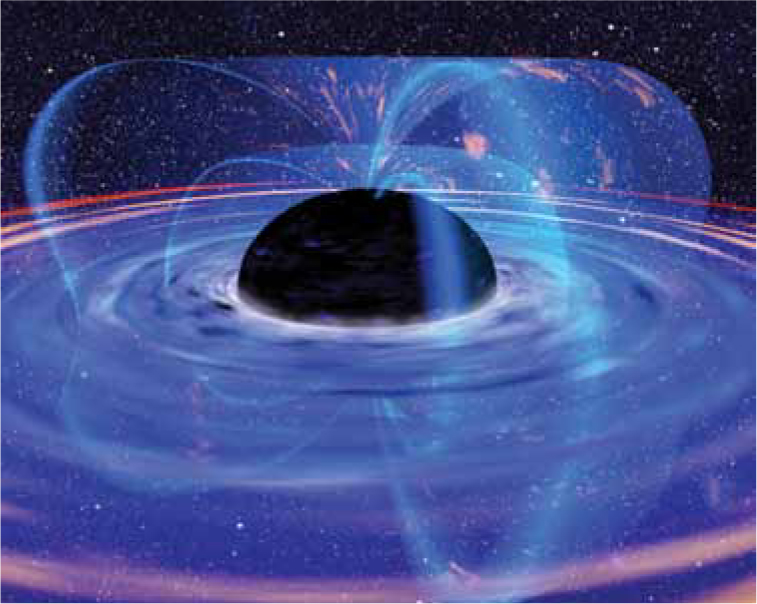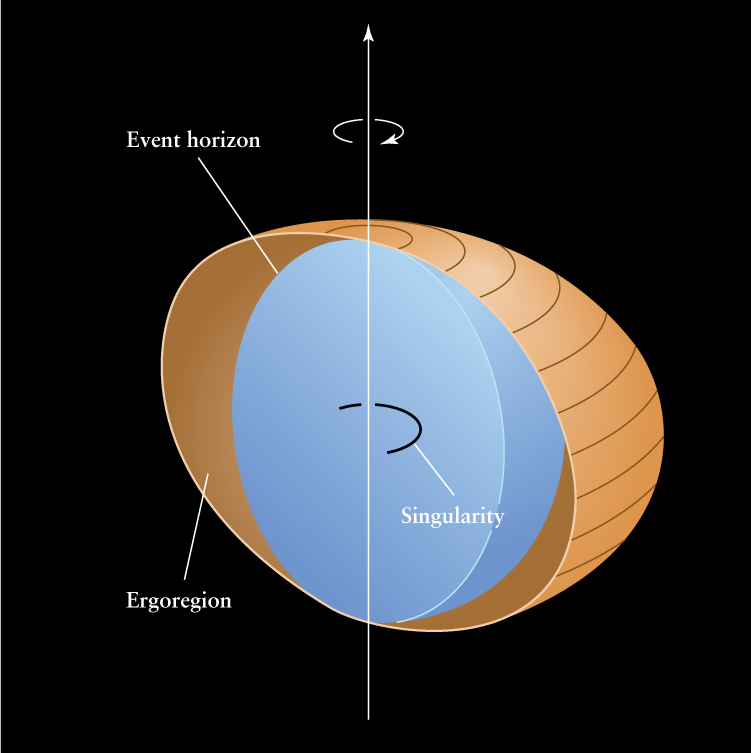21-7 Just three numbers completely describe the structure of a black hole
Because light and matter cannot escape the event horizon, we are prevented from ever knowing much about what has already fallen into a black hole. In this sense a black hole would appear to be an “information sink.” Many properties of an object that falls into a black hole, such as the object’s chemical composition, texture, color, shape, and size, would appear to vanish as soon as it crosses the event horizon.
When an object falls into a black hole, all information about that object disappears except its mass, electric charge, and angular momentum
Because this information has seemingly vanished, it cannot affect the basic structure or properties of the hole. For example, consider two hypothetical black holes, one made from the gravitational collapse of 10 M⊙ of iron and the other made from the gravitational collapse of 10 M⊙ of peanut butter. Obviously, quite different substances went into the creation of the two holes. However, once the event horizons of these two black holes have formed, both the iron and the peanut butter will have permanently disappeared from the universe. As seen from the outside, the two holes are identical, making it impossible for us to tell which ate the peanut butter and which ate the iron. A black hole is thus unaffected by the type of matter it consumes.
The Three Properties of a Black Hole
Because a black hole appears to be an information sink, it is reasonable to wonder whether we can determine anything at all about a black hole. What properties do characterize a black hole?
First, we can measure the mass of a black hole. One way to do this would be by placing a satellite into orbit around the hole. After measuring the size and period of the satellite’s orbit, we could use Newton’s form of Kepler’s third law (recall Section 4-7 and Box 4-4) to determine the mass of the black hole. This mass is equal to the total mass of all the material that has gone into the hole.
Second, we can also measure the total electric charge possessed by a black hole. Like gravity, the electric force acts over long distances—it is a long-range interaction that is felt in the space around the hole. Appropriate equipment on a space probe passing near the hole could measure the strength of the electric force, and the electric charge could thus be determined.
In actuality, we would not expect a black hole to possess much, if any, electric charge. For example, if a hole did happen to start off with a sizable positive charge, it would vigorously attract vast numbers of negatively charged electrons from the interstellar medium, which would soon neutralize the hole’s charge. For this reason, astronomers usually neglect electric charge when discussing real black holes.
Although a black hole might theoretically have a tiny electric charge, it can have no magnetic field of its own whatsoever. We discussed in Section 21-3 how magnetic fields are involved in producing jets from black holes. However, these fields are associated with the accretion disk around the black hole, not the black hole itself. When a black hole is created, however, the collapsing star from which it forms may possess an appreciable magnetic field. The star must therefore radiate this magnetic field away before it can settle down inside its event horizon. Theory predicts that the star does this by emitting electromagnetic and gravitational waves. As we saw in Section 21-2, gravitational waves are ripples in the overall geometry of space. Various experiments soon to be in operation may detect bursts of gravitational radiation emitted by massive stars as they collapse to form black holes.
Third, we can detect the effects of a black hole’s rotation, that is, measure its angular momentum. An object’s angular momentum is related to how fast it rotates and how the object’s mass is distributed over its volume. As a dead star collapses into a black hole, its rotation naturally speeds up as its mass moves toward the center, just as a figure skater rotates faster when she pulls her arms and legs in. This same effect explains the rotation of the solar nebula (see Section 8-4), as well as why neutron stars spin so fast (see Section 20-11). We expect a black hole that forms from a rotating star to be spinning very rapidly.
Rotating Black Holes
When the matter that collapses to form a black hole is rotating, that matter does not compress to a point. Instead, it collapses into a ring-shaped singularity located between the center of the hole and the event horizon (Figure 21-18). The structure of such rotating black holes was first worked out in 1963 by the New Zealand mathematician Roy Kerr. Most rotating black holes should be spinning thousands of times per second, even faster than the most rapid pulsars.


If a rotating black hole is surrounded by an accretion disk with a magnetic field, it may be possible for the magnetic field to steal some of the rotational energy and angular momentum from the black hole and transfer it to the disk. The magnetic field acts as a “brake” that retards the black hole’s rotation and makes the disk’s rotation speed up. (On Earth, magnetic braking is used to slow locomotives, amusement park rides, and hybrid cars to a smooth stop without generating excess heat.) Figure 21-19 shows an arching magnetic field that connects an accretion disk with a rotating black hole in just this way. This process may be taking place with the supermassive black hole at the center of the galaxy MCG–6-15-30. Observations with the XMM-Newton telescope (see Section 6-7) indicate that unusually intense X-rays are coming from the accretion disk around this black hole. The suspicion is that the energy to power this radiation may be extracted from the black hole’s rotation. (This transfer of energy and angular momentum can also go the other way. The image that opens this chapter depicts a system in which magnetic fields are thought to transfer angular momentum to a black hole from its accretion disk. Robbing the accretion disk of its rotation makes it easier for its material to fall into the black hole.)
Even a rotating black hole without an accretion disk can transfer energy to other objects. This energy transfer is possible according to Einstein’s general theory of relativity, which makes the startling prediction that a rotating body drags spacetime around it. (Very precise spacecraft measurements indicate that the rotating Earth drags spacetime in just this way.) Surrounding the event horizon of every rotating black hole is a region where this dragging of space and time is so severe that it is impossible to stay in the same place. No matter what you do, you get pulled around the hole, along with the rotating geometry of space and time. This region, where it is impossible to be at rest, is called the ergoregion (see Figure 21-18).
To measure a black hole’s angular momentum, we could hypothetically place two satellites in orbit about the hole. Suppose that one satellite circles the hole in the same direction the hole rotates and the other in the opposite direction. One satellite is thus carried along by the geometry of space and time, but the other is constantly fighting its way “upstream.” The two satellites will thus have different orbital periods. By comparing these two periods, astronomers can deduce the total angular momentum of the hole.
Because the ergoregion is outside the event horizon, this bizarre region is accessible to us, and spacecraft could travel through it without disappearing into the black hole. According to detailed calculations, objects grazing the ergoregion could be catapulted back out into space at tremendous speeds. In other words, the ejected object could leave the ergoregion with more energy than it had initially, having extracted added energy from the hole’s rotation. This process is called the Penrose process, after Roger Penrose, the British mathematician who proposed it.
Mass, charge, and angular momentum are the only three properties that a black hole possesses. This simplicity is the essence of the no-hair theorem, first formulated in the early 1970s: “Black holes have no hair.” In other words, “hair” would be some property of a black hole other than mass, charge, or angular momentum, yet another property is not possible. Therefore, once an object has fallen into a black hole, except for the object’s mass, charge, and angular momentum, any additional properties carried by the object disappear from the universe. However, the idea that black holes can completely remove information from the universe is contentious, as some scientists do not think information is ever truly lost. We will revisit black hole information in Section 21-9, where subtle quantum effects might help resolve the issue.
CONCEPT CHECK 21-14
Consider two black holes. They have the same mass and angular momentum, and the total electric charge for each of them is zero. According to the no-hair theorem, could we tell if one of these black holes was made from iron and the other from peanut butter?
No. Once matter enters a black hole, the only properties of the black hole are its mass, charge, and angular momentum.